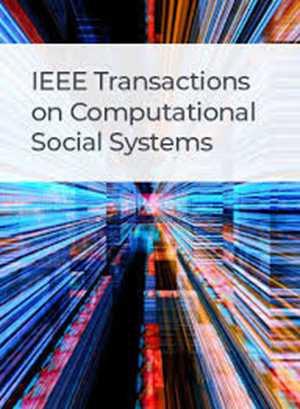多路复用元群体网络上带有搁浅机制的耦合流行病-信息传播
IF 4.5
2区 计算机科学
Q1 COMPUTER SCIENCE, CYBERNETICS
IEEE Transactions on Computational Social Systems
Pub Date : 2024-06-14
DOI:10.1109/TCSS.2024.3404239
引用次数: 0
摘要
承认信息传播和个体适应行为的重要性被认为是全面了解流行病传播不可或缺的先决条件。最近的研究广泛考虑了元种群模型,即流行病通过个体流动在单层物理网络上传播。然而,这些进展忽视了与流行病相关的伴随信息干预和个体行为反应。在本文中,我们利用微观马尔可夫链(MMC)方法,在多重元种群网络上建立了一个流行病-信息传播耦合模型,旨在探索流行病传播过程的时空特征。考虑到个体的适应行为,引入了基于感染水平和医疗资源的搁浅机制,以捕捉个体在不同斑块间流动时的种群规模动态。在改进的框架下,理论流行阈值得到了分析推导。为了验证我们的理论分析,并进一步研究信息传播和扩散参数对流行阈值和稳态流行率的影响,我们进行了大量的数值模拟。我们的结果表明,信息扩散的规模和传播参数的具体配置都能显著抑制流行病的流行。这些发现为时空视角下流行病-信息耦合过程的理论研究和决策提供了新的启示。本文章由计算机程序翻译,如有差异,请以英文原文为准。
Coupled Epidemic-Information Propagation With Stranding Mechanism on Multiplex Metapopulation Networks
Acknowledging the significance of information propagation and individual adaptive behavior has been regarded as an indispensable prerequisite for a complete understanding of epidemic spreading. Recent studies have widely considered the metapopulation model, where epidemics spread over a single layer of physical networks via individual mobility. However, these advances neglected the interventions of accompanied information and individual behavior response related to epidemics. In this article, we develop a coupled epidemic-information propagation model on multiplex metapopulation networks leveraging the microscopic Markov chain (MMC) approach, aiming to explore the spatiotemporal characteristics of epidemic spreading process. Taking the individual adaptive behavior into account, the stranding mechanism based on infection level and medical resources is introduced to capture the population size dynamics during individual mobility among different patches. Theoretical epidemic threshold is analytically derived under the improved framework. Extensive numerical simulations are performed to validate our theoretical analysis and further examine the impacts of information propagation and spreading parameters on epidemic threshold and steady-state prevalence. Our results indicate that both the scale of information diffusion and the specific configuration of spreading parameters can significantly suppress the epidemic prevalence. These findings shed a novel light on theoretical research and decision-making of coupled epidemic-information process in the spatiotemporal perspective.
求助全文
通过发布文献求助,成功后即可免费获取论文全文。
去求助
来源期刊

IEEE Transactions on Computational Social Systems
Social Sciences-Social Sciences (miscellaneous)
CiteScore
10.00
自引率
20.00%
发文量
316
期刊介绍:
IEEE Transactions on Computational Social Systems focuses on such topics as modeling, simulation, analysis and understanding of social systems from the quantitative and/or computational perspective. "Systems" include man-man, man-machine and machine-machine organizations and adversarial situations as well as social media structures and their dynamics. More specifically, the proposed transactions publishes articles on modeling the dynamics of social systems, methodologies for incorporating and representing socio-cultural and behavioral aspects in computational modeling, analysis of social system behavior and structure, and paradigms for social systems modeling and simulation. The journal also features articles on social network dynamics, social intelligence and cognition, social systems design and architectures, socio-cultural modeling and representation, and computational behavior modeling, and their applications.
 求助内容:
求助内容: 应助结果提醒方式:
应助结果提醒方式:


